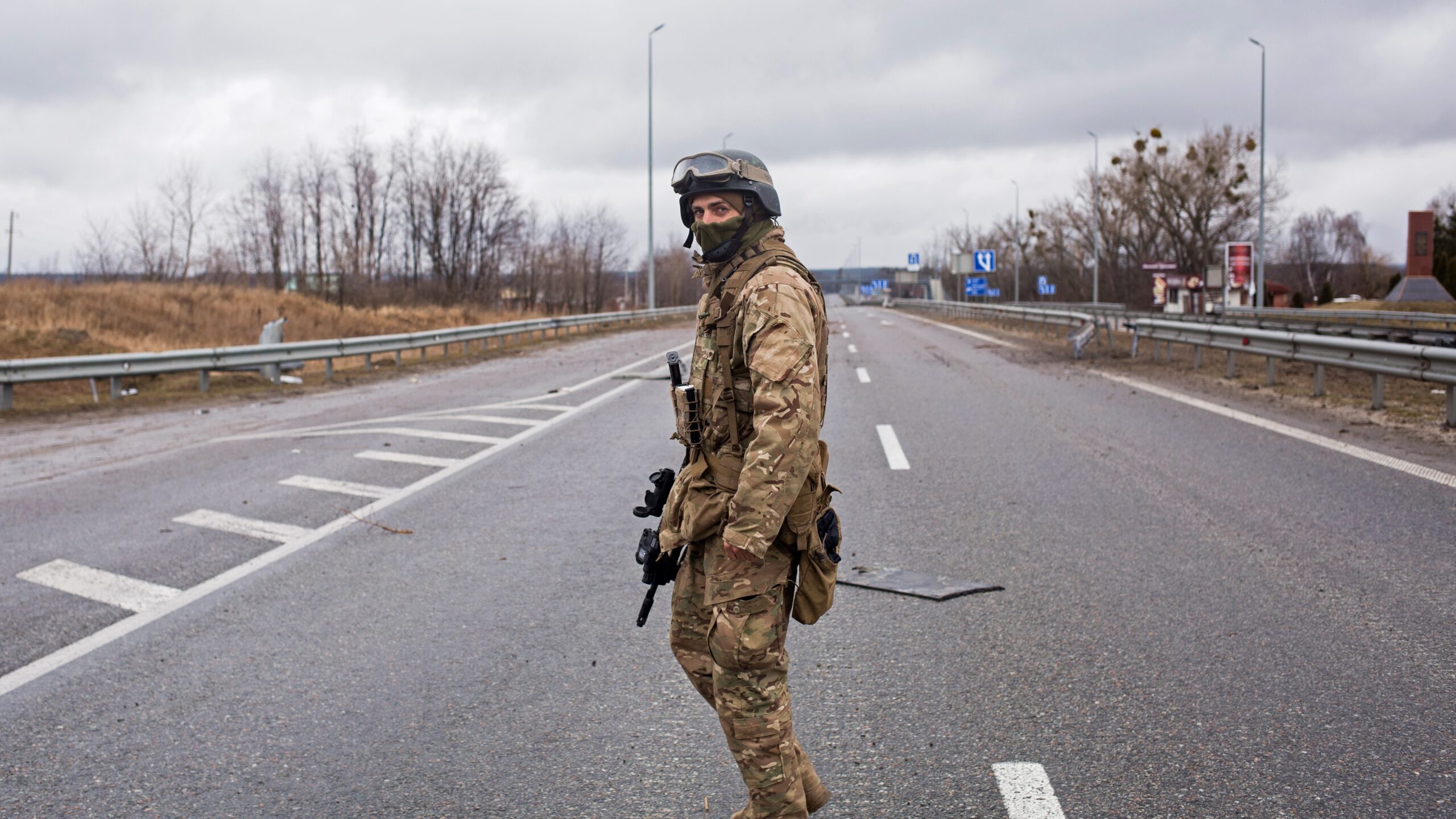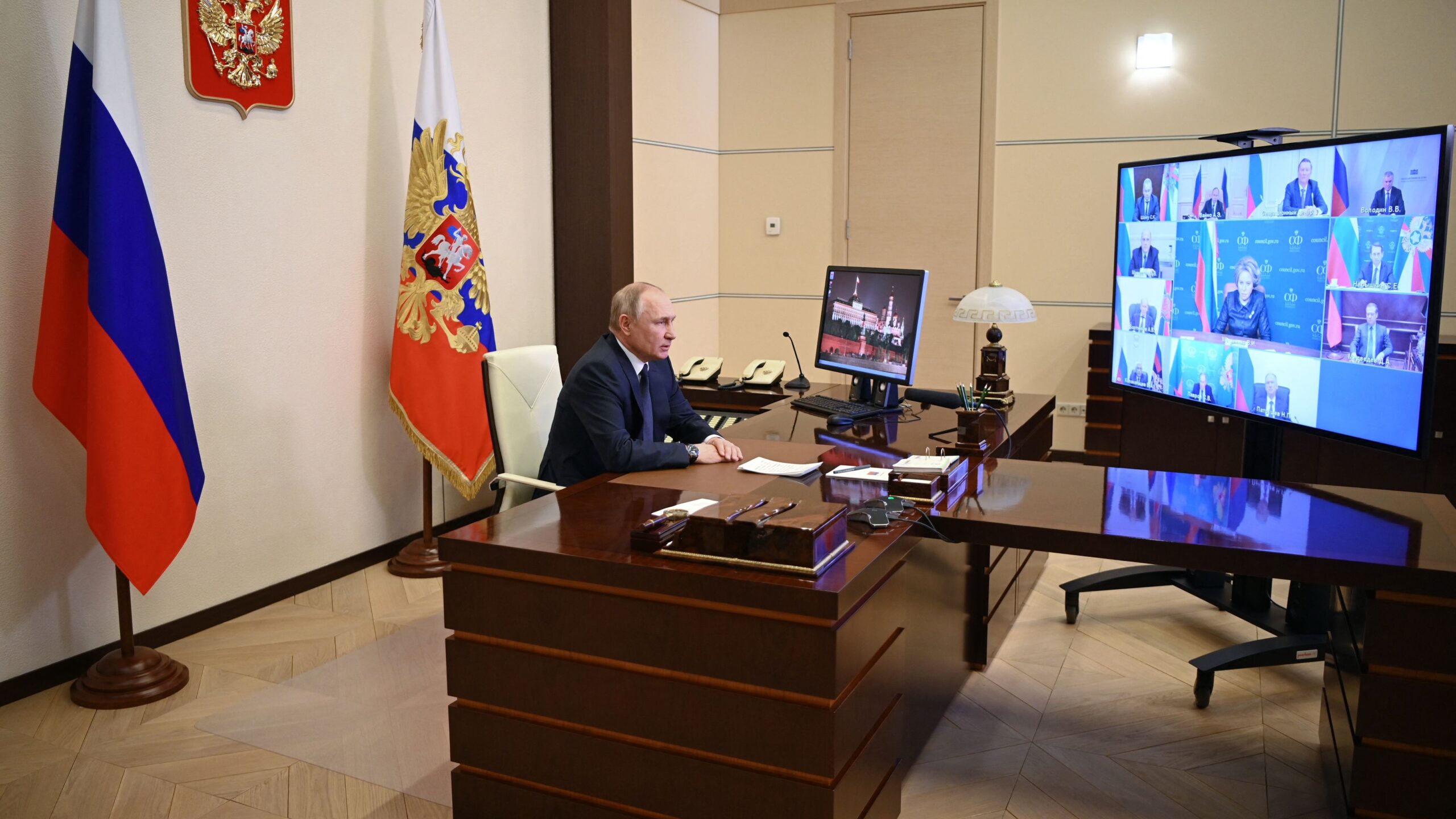
A Ukrainian serviceman patrols on March 3, 2022 in Sytniaky, Ukraine, west of the capital. (Anastasia Vlasova/Getty Images)
Editor’s note: The following is a report from Reuben F. Johnson, who has written for Breaking Defense in recent years from Ukraine. This piece was written over several days, as Johnson relocated from shelter to shelter to avoid Russian strikes in the Kyiv area, with limited access to internet and power. Given that, statistics and facts on the ground may have shifted by publication; as Johnson himself put it in an email, “everything is fluid right now.” We present this piece to give a sense for the view from the ground, and hope Johnson and his family remain safe in the days ahead. For our ongoing coverage of the Ukraine crisis, click here.
KYIV: Explosions in Kyiv began around 5 in the morning of Feb. 23. Sites initially targeted by Russian Kalibr cruise missiles, produced by the Ekaterinburg, Russia-based Novator defence enterprise, included facilities close to the civilian Kyiv/Borispol international airport. The airport was then closed after a bombardment the same morning and has never reopened.
Shortly after Russia launched its invasion, a woman stood in central Moscow with the well-known Red Square and Lenin Masoleum in the background and held up a small sign reading the war on Ukraine was Pozor Rossii, “Russia’s Infamy.” Her description has turned out to be more than prescient.
There have now been days of intense fighting in and around major Ukrainian cities. Stories of individual bravery on the part of the Ukrainian forces — some of them heart-breaking — are circulating everywhere thanks to a network of social media sites, Ukraine news channels and other outlets. Pre-war speculation was that the entirety of Ukraine’s mobile and internet infrastructure would be destroyed by Russian cyberattacks, but no such shutdown of communications has yet occurred.
The overall assessment at this point by US and other NATO-nation observers is that despite almost a year’s worth of preparation by the Russian armed forces that had been massing at several points along the Ukraine border, the invasion is a “disaster and a borderline failure,” as one former US military officer, now working as a civilian contractor in Poland, told Breaking Defense.
Now, on the seventh day of the Russian-Ukrainian war, as additional columns of Moscow’s military vehicles — with what are described as “more battle-ready units” — are rolling towards the Ukrainian capital, two questions seem to be emerging.
First, how it is that the vaunted and feared Russian military, the focus of so many NATO wargames and planning sessions, has been unable to overwhelm the significantly smaller Ukrainian defenders? And second, faced with opposition that didn’t quickly roll over, what scenario is now likely to come from the forces of Russian President Vladimir Putin?
Amateurs Focus on Tactics, Professional Soldiers Study Logistics
For months these formations were allegedly building up a robust logistics chain, including blood packs and other medical supplies. Despite these preparations, on the third day of the war Russian units were already running out of rations.
One “Five Eyes” nation former intelligence officer on temporary duty in Kyiv informed Breaking Defense “Russian troops have been foraging, looting, and trading with civilians for food. If they are already running short of rations [on day three] then their logistics must be struggling immensely – and must have been so even all of these months in these staging areas.”
TV news channels have since broadcast video from security surveillance CCTV cameras inside of supermarkets showing Russian soldiers looting the stores of endless amounts of foodstuffs and then ransacking the tills in the check-out lanes and dumping bundles of the national currency, the Hrynva, into sacks Bonnie and Clyde-style.
Ukrainian Armed Forces (ZSU) sources state that multiple Russian units were already out of petrol by the third day of the war and were running low on ammunition as well. In Kharkiv, groups of as many as ten demoralized Russian soldiers are reported to have surrendered to the first, lone representative of the Ukrainian forces they encounter.
Russia has also suffered at least one high-level loss: Maj. Gen. Andrei Sukhovetsky, the commanding general of the Russian 7th Airborne Division, who was reportedly killed earlier this week by Ukrainian forces.
More than one commentator from more than one nation has repeated the quote attributed to every famous military leader from Napoleon to Omar Bradley: “Amateurs focus on tactics, professional soldiers study logistics,” – and has then added the Russians seem to have forgotten that essential bit of military wisdom.

A woman sits in a tent as people take shelter in the Dorohozhychi subway station which has has been turned into a bomb shelter on March 02, 2022 in Kyiv, Ukraine. (Chris McGrath/Getty Images)
Russian military sources, speaking on background, also now admit the invasion was deeply flawed from the start. “There was no tactical plan,” said one. “Our plan, to the extent that there was one, was to ‘play it by ear’ and to just cope with any resistance as it appeared. This was because the expectation had been that we would take all these cities in one to four days and that Ukraine’s military would be immediately overwhelmed.”
Those who have watched the evolution — or rather the deterioration — of Russia’s military and the defense-industrial base that supports it are pointing out that the poor performance of Moscow’s forces has been a process unfolding for years now.
Today “Russia has no more Kalibr missiles left in strategic reserve,” said a Ukrainian defense enterprise director familiar with the program, “but that is not the end of their troubles. The guidance system, the seeker head and other critical modules [in the missile’s front end] contain about 60% imported electronic components. None of these will be available after the long list of sanctions being imposed on Russia now, so it is hard to see where any new missiles would ever come from.”
Ukrainian defense firms have deep insight into Russia’s defense industry, given how closely the two countries were tied up until 2014. Many of those social ties have remained in place even as relations between the two countries deteriorated.
The Kalibr is not the only program in trouble. One Ukrainian intelligence officer tells Breaking Defense that there are “numerous shortages of [Russian] weapon systems. The famous KBM plant in Tula and other factories controlled by longtime Putin allies the Rothenberg brothers are unable to physically fulfil orders for infantry weapons and ammunition.
RELATED: Ukraine’s Turkish-made drones face off against advanced Russian military
“Weapons that are officially on the books and should be available for delivery to active-duty units are missing and the next production runs will be complete only in three to four months,” the officer said. Even that estimate assumes that the raw material inputs have not been pilfered as well and are still available — if not, the time frame could be considerably longer.
Russia’s forces have also not properly factored in the use by the Ukrainians of unmanned combat aircraft, specifically the TB2 Bayaktar armed strike drones which Kyiv have acquired from Turkey. Several Russian columns have been hit by these UCAVs, including one near Kharkiv, and there are news reports that Turkey has already shipped more TB2 systems to Ukraine since the invasion began.
What Happened to the Russian Military Playbook?
There was a early consensus among Washington talking heads, even before the conflict began, that the Ukrainians would never be able to prevail due to Moscow’s sheer superiority in numbers. That assessment assumed that the tens of thousands of pages published in past years in Russian military journals actually represented how the battle plan in Ukraine would play out.
But in the field this past week the Russian Army has behaved as though these plans never existed in the first place. Quoting again from the former Five Eyes intelligence officer:
- “Russian tactical doctrine has been absent. They are taking exceptionally risky gambles that defy military logic, particularly since they lack air superiority. Tank units have been sent into urban areas with no infantry screen. Joint fires coordination is poor everywhere except on the Crimea-Kherson front. This ignores long-running historic doctrinal principles that rely on massed joint fires.”
- “Russia’s Aerospace Force (VKS) seems to be failing in its mission to achieve air superiority. Not only is the Ukrainian Air Force (PSU) operating both manned and unmanned platforms successfully,” but almost 30 Russian fixed-wing aircraft and a like number of helicopters have been downed, per Ukrainian statistics. An unnamed Ukrainian Mikoyan MiG-29 pilot nicknamed “the Ghost of Kyiv” has supposedly downed more than 16 Russian aircraft; fact checkers are less confident in the pilot’s existence, but the story has proved a powerful rallying point.
- “Despite its importance in modern Russian battle plans and extensive employment in the Donbas, Moscow’s legendary prowess with electronic warfare seems non-existent. Many of the most advanced systems that been at the top of the EW threat list appear to have never been engaged.”
Losses by Moscow’s military appear to be disastrously lopsided, given the overwhelming force arranged on Ukraine’s border over a two month period. Getting accurate data on the situation is nearly impossible, but as of Thursday morning, official Ukrainian statistics claim almost 9,000 Russian troops have been lost. For comparison, Soviet combat losses after almost a decade in Afghanistan totaled 15,000. The Ukrainian MoD also claims that Russia has lost more than 200 tanks, in excess of 900 armored vehicles, plus dozens of air defense units, artillery systems, motorized vehicles and other hardware.
Given the source, those figures are likely overstating the strength of the victories. For comparison, the independent Oryxspioenkop website, which has been tracking action through open-source intelligence, claims Russia has lost over 530 vehicles, including 220 destroyed, 130 abandoned by Russian forces, and 178 captured by Ukraine. True counts, however, are effectively impossible to come by.
Drone footage showed destruction of buildings and burnt out Russian military vehicles in Ukraine’s Borodyanka, a town near Kyiv where locals claimed they had repelled a Russian assault https://t.co/fxUQvGWe9W pic.twitter.com/VWdon9Pzrf
— Reuters (@Reuters) March 3, 2022
Ukraine sources believe that Putin gave little thought to a “what if” contingency should the war turn into a protracted, costly conflict. If combat operations last more than ten days, the Ukrainians believe, the Russian side may have no choice other than to negotiate – as there will not be adequate resources left to commit to the field. According to one estimate, the war is costing Putin up to US $20 billion per day, which is an unsustainable trajectory.
At press time, it appeared the Belarus military might be sent across the border into Ukraine on Russia’s side to try and overwhelm the Ukrainians. However, one of the most high-profile opponents of Belarusian strongman Alexander Lukashenko, Vadim Prokopiev, who is now in Kyiv heading up resistance efforts, told Breaking Defense that “committing the Belarusian military might be far less effective than Putin hopes. Demoralization among these troops is widespread – even more so than some of the Russian units that have already surrendered here in large numbers.”
Putin’s Dilemma
Prior to the invasion, there appear to have been few internal voices warning Putin that the operation could go south very rapidly, but that doesn’t mean no one predicted it.
Col. Gen. Leonid Ivashov, a well-respected former Russian officer, warned that an invasion of Ukraine would lead to multiple catastrophic consequences for Russia, almost all of which have now come to pass. In a strongly worded letter shared with the All-Russian Officers’ Assembly, he went so far as to demand Putin resign for even considering starting such a conflict.
As Ivashov warned, a wave of sanctions, embargos and western firms such as Boeing refusing to continue supplying parts and services is causing crippling damage to Russia’s economy. As of Thursday, the Russian ruble is trading at over 109 to the US dollar, while countries around the world are moving to claim Russian assets — including a number of superyachts owned by Putin’s closest circle. Russia now stands a very good chance of becoming a nation as isolated and cut off from the international financial system as Iran or the Democratic People’s Republic of Korea.
At home, there have been signs of an anti-war movement popping up, despite police quickly moving to arrest anyone who speaks up. The assumption of a quick victory and low casualties meant that the Kremlin’s propaganda machine had organized almost no counter-narratives to the anti-war movement and has been scrambling; there is now a growing belief Putin will declare martial law in the coming days.
Due to Putin’s increasing need to create phantom enemies abroad (invoking the red herring specter of Ukraine someday joining NATO), domestic “traitors” such as Aleksei Navalniy and an overall narrative of victimhood that has been visited mercilessly on Russia in general and him personally, victory in this war with Ukraine has become almost synonymous with the chances for his regime’s continued survival.
And yet, no preparations seem to have been made if the Russian Army failed in its mission.
A leading Ukrainian military commentator, Yuri Butusov, detailed one of the more high-profile successes by the ZSU and calling the botched invasion “a defeat that Putin cannot hide.” This particular incident has shades of the ingenuity Israel’s military was famous for in the initial years of its existence – utilizing outmoded technology to achieve tactical surprise.

Russian President Vladimir Putin chairs a meeting with members of the Security Council via teleconference call at the Novo-Ogaryovo state residence outside Moscow, Russia on March 3, 2022. (ANDREY GORSHKOV/SPUTNIK/AFP via Getty Images)
“In response to bombing and missile attacks on Ukrainian cities, the Ukraine 19th Missile Brigade fired previous-generation Tochka-U ballistic missiles at Russia’s Millerovo airbase and destroyed at least two of the newest-model VKS Sukhoi Su-30SM fighter aircraft,” he wrote on the second day of hostilities. “Ukraine managed to inflict this loss [on the Russians] using missiles more than 30 years old. The whole world can say what they want about our weakness, but we will use everything we have and everything we can to fight for our freedom.”
What makes observers increasingly nervous at this point, said the former Five Eyes nation intelligence officer, is “we’re now entering a very dangerous phase in which Russia may use its more indiscriminate weapons at scale to break urban resistance, especially in Kharkiv, but maybe even in Kyiv.” Some of this has already been seen in the Russian use of cluster munitions, which are banned by international convention, in bombings of Kharkiv, as well as the fear that Russia will use thermobaric weapons.
In Kyiv, the military leadership echoes these concerns and officially assess Moscow has come to the conclusion it cannot overcome the ZSU in the field, so Putin has now turned to terrorizing the Ukrainian population at large. Recent attacks on the city have included hits on the main TV tower that is near the Babyn Yar Holocaust memorial, the main rail station and even centuries-old UNESCO-designated sites like St. Sophia’s cathedral.
More worrying are the growing speculations about the president-for-life’s mental and emotional state, something that has become a more mainstream concern over the last week.
“Putin has all the appearances of a man whose state of mind has deteriorated to the point where he is seriously contemplating bringing about the end of the world before his own regime might come to an end,” said one former Polish intelligence officer on condition of anonymity. “The longer this war continues without the EU, NATO, the US stepping to set up a no-fly zone and prevent this conflict from becoming even more violent and combustible, the closer we get to this unthinkable scenario.”
Given that a no-fly zone has been categorically ruled out by leaders in the US and UK — setting one up would be tantamount to declaring war on Russia, which is the line the NATO nations have studiously avoided in allowing Russia to invade Ukraine in the first place — all the world can do is continue to watch and wait, nervously, as the Ukraine situation plays out.
Air Force picks Anduril, General Atomics for next round of CCA work
The two vendors emerged successful from an original pool of five and are expected to carry their drone designs through a prototyping phase that will build and test aircraft.


























